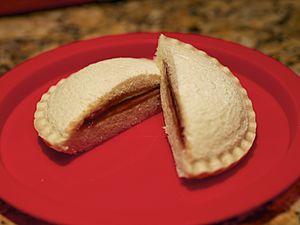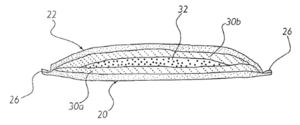Sealed crustless sandwich facts for kids

A sealed crustless sandwich with peanut butter and jelly filling.
|
|
| Type | Sandwich |
|---|---|
| Course | Lunch, Snack |
| Place of origin | United States |
| Main ingredients | Bread, various fillings |
A sealed crustless sandwich is a type of sandwich with the crusts removed. It has a filling sealed between two layers of bread that are pressed together around the edges.
You can make these sandwiches at home. They can be square, round, or triangular. People use tools like forks to crimp, or press, the edges together. This is similar to how you might seal a pie crust or a ravioli. There are also special cutters that cut off the crust and seal the sandwich at the same time.
Many companies also sell them pre-made. These are usually frozen and wrapped individually, making them a quick and easy snack. The most famous brand is Uncrustables, which first appeared in 1995 with a peanut butter and jelly filling. These sandwiches are very convenient because you can take them anywhere. They have even been called "the Swiss Army knife of foods" because they are so useful.
Contents
Who Eats Them?
Sealed crustless sandwiches were first made for kids' school lunches. But people of all ages enjoy them. They are an easy food to pack for lunch or a snack.
They are also popular with groups that need quick food. In 2018, these sandwiches were given to firefighters who were battling the California wildfires. Even National Football League (NFL) teams buy thousands of them for their players to eat as snacks.
Making Sandwiches in Factories
In the United States, factory-made crustless sandwiches first appeared in 1995. They were created by David Geske and Len Kretchman in Fargo, North Dakota. By 1998, their company, Menusaver, was making about 35,000 sandwiches a day for schools. In 1998, The J.M. Smucker Company bought their company. In Japan, a company called Yamazaki Baking has been selling similar sealed sandwiches called Lunch Pack since 1984.
Companies make these sandwiches in many shapes, like squares, triangles, circles, and even clouds. They also come with a wide variety of fillings:
- Ham and cheese
- Chocolate-hazelnut spread
- Peanut butter and honey
- Peanut butter and jelly
To keep the jelly from making the bread soggy, some companies put a layer of peanut butter on both slices of bread first. This creates a barrier that protects the bread from the jelly.
Popular Brands
Many companies sell their own versions of sealed crustless sandwiches. Some of the most well-known brands in the U.S. include:
- Uncrustables by Smucker's
- No Crust Sandwiches by Walmart
- PB + J Crustless Sandwiches by Costco
- Good & Gather Sunbutter and Jelly Sandwiches by Target
- PB Jamwiches by Tyson Foods
- Chubby Snacks
Smucker's has plants in Kentucky, Colorado, and Alabama. In 2021, sales of Uncrustables were around $500 million. The company spent about ten years perfecting its design to stop the filling from leaking out.
The Fight Over the Sandwich
Because these sandwiches are so popular, there have been legal disagreements over who is allowed to make and sell them.
The Patent Problem
A patent is an official document that gives an inventor the exclusive right to make and sell their invention for a set number of years. The original creators of Uncrustables received a patent for their "sealed crustless sandwich."
The patent described a simple idea: a sandwich with filling between two pieces of bread, with the crusts cut off and the edges crimped shut. Many people felt this idea was too obvious to deserve a patent. After all, people had been making sandwiches and cutting off the crusts for a long time.
Later, people found older patents and books that described similar ideas. For example, a 1949 patent described a tool for making sealed sandwiches. Because of this "prior art" (older inventions and ideas), the United States Patent and Trademark Office eventually cancelled the patent in 2007. This meant the idea of a sealed crustless sandwich was no longer owned by one company.
Smucker's vs. Small Businesses
Even without the patent, Smucker's claimed it had a trademark on the round shape of its Uncrustables sandwiches. A trademark protects a brand's name, logo, or unique look. Smucker's sent letters to other companies, including small businesses, telling them to stop selling round crustless sandwiches.
One of these companies was Albie's Foods in Michigan. Albie's argued that their sandwiches were like a pasty, a traditional food in their area. A court agreed that Albie's was not violating Smucker's rights.
Another company, Gallant Tiger, also received a letter from Smucker's. Gallant Tiger sold fancy sandwiches with flavors like "chai spiced pear butter and peanut butter." The founder was surprised that a giant company like Smucker's would be concerned about his small business. He said that customers can tell the difference between two brands of pizza even if they are both round, so they should be able to tell the difference between two brands of sandwiches. In the end, Gallant Tiger changed its sandwich shape to avoid a legal fight.
See also



